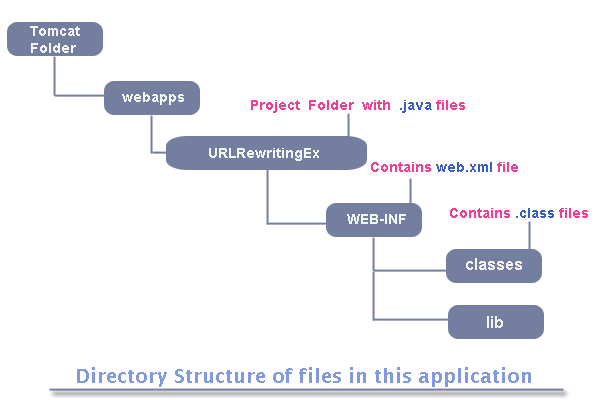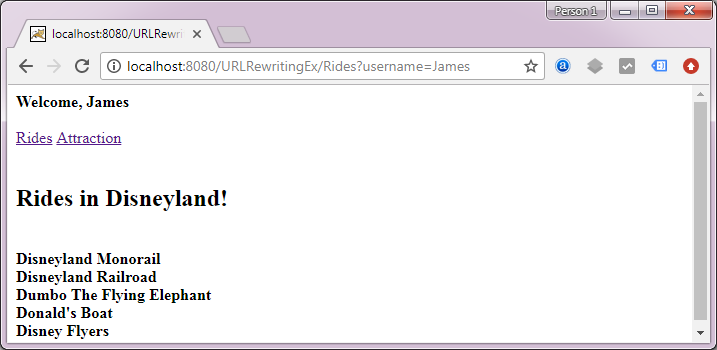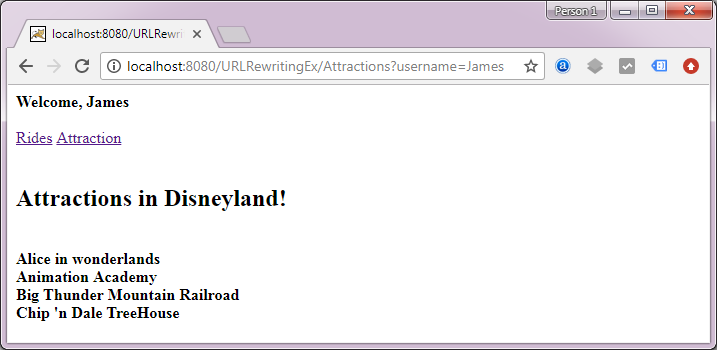Advertisement
http://www.decodejava.com/MyServlet?name="admin"&message="never give up!" <html>
<head>
<title> URL Rewriting Demo </title>
</head>
<body>
<b>Welcome to Disneyland! Please enter your details.</b>
<br/>
<br/>
<br/>
<form action = "Welcome" method="get" >
Name : <input type = "text" name = "username"/>
City : <input type = "text" name = "cityname"/>
<input type = "submit" name = "submit"/>
</form>
</body>
</html>import java.io.*;
import javax.servlet.*;
import javax.servlet.http.*;
import java.util.*;
public class MyServlet1 extends HttpServlet
{
public void doGet(HttpServletRequest request, HttpServletResponse response) throws ServletException, IOException
{
response.setContentType("text/html");
PrintWriter out = response.getWriter();
//Reading parameters
String name = request.getParameter("username");
String city = request.getParameter("cityname");
//Welcoming the user
out.println("<b>" + "Welcome, " + name + " from " + city + "</br>");
out.println("<br/> <br/>");
//Passing the request parameters in a call to the next Servlet
out.println("<a href = 'Rides?username="+name+"'>rides</a>");
out.println("<a href = 'Attraction?username="+name+"'>attraction</a>");
out.println("<br/> <br/> <br/>");
out.println("<b>Click on the links above for the information about Disneyland. </b>");
}
}import java.io.*;
import javax.servlet.*;
import javax.servlet.http.*;
public class MyServlet2 extends HttpServlet
{
public void doGet(HttpServletRequest request, HttpServletResponse response) throws ServletException, IOException
{
response.setContentType("text/html");
PrintWriter out = response.getWriter();
//Reading parameters
String name = request.getParameter("username");
String city = request.getParameter("cityname");
//Welcoming the user
out.println("<b>"+ "Welcome, " + name + "</b>");
out.println("<br/> <br/>");
//Passing the request parameters in a call to the next Servlet
out.println("<a href = 'Rides?username="+name+" '>rides</a>");
out.println("<a href = 'Attraction?username="+name+" '>attraction</a>");
out.println("<br/> <br/>");
out.println("<h2>Attractions in Disneyland! </h2> <br/>");
out.println("<b> Alice in wonderlands</b> <br/>");
out.println("<b> Animation Academy </b> <br/>");
out.println("<b> Big Thunder Mountain Railroad </b> <br/>");
out.println("<b> Chip 'n Dale TreeHouse </b> <br/>");
}
}import java.io.*;
import javax.servlet.*;
import javax.servlet.http.*;
public class MyServlet3 extends HttpServlet
{
public void doGet(HttpServletRequest request, HttpServletResponse response) throws ServletException, IOException
{
response.setContentType("text/html");
PrintWriter out = response.getWriter();
//Reading parameters
String name = request.getParameter("username");
String city = request.getParameter("cityname");
//Welcoming the user
out.println("<b>"+ "Welcome, " + name + "</b>");
out.println("<br/> <br/>");
//Passing the request parameters in a call to the next Servlet
out.println("<a href = 'Rides?username="+name+" '>rides</a>");
out.println("<a href = 'Attraction?username="+name+" '>attraction</a>");
out.println("<br/> <br/>");
out.println("<h2>Rides in Disneyland! </h2> <br/>");
out.println("<b> Disneyland Monorail </b> <br/>");
out.println("<b> Disneyland Railroad </b> <br/>");
out.println("<b> Dumbo The Flying Elephant </b> <br/>");
out.println("<b> Donald's Boat </b> <br/>");
out.println("<b> Disney Flyers </b> <br/>");
}
}Advertisement

<?xml version="1.0" encoding="UTF-8"?>
<web-app xmlns="http://xmlns.jcp.org/xml/ns/javaee"
xmlns:xsi="http://www.w3.org/2001/XMLSchema-instance"
xsi:schemaLocation="http://xmlns.jcp.org/xml/ns/javaee
http://xmlns.jcp.org/xml/ns/javaee/web-app_4_0.xsd"
version="4.0"
metadata-complete="true">
<display-name>Welcome tomcat</display-name>
<description>
Welcome tomcat
</description>
<servlet>
<servlet-name>Servlet1Welcome</servlet-name>
<servlet-class>MyServlet1</servlet-class>
</servlet>
<servlet>
<servlet-name>ServletAttraction</servlet-name>
<servlet-class>MyServlet2</servlet-class>
</servlet>
<servlet>
<servlet-name>ServletRides</servlet-name>
<servlet-class>MyServlet3</servlet-class>
</servlet>
<servlet-mapping>
<servlet-name>ServletWelcome</servlet-name>
<url-pattern>/Welcome</url-pattern>
</servlet-mapping>
<servlet-mapping>
<servlet-name>ServletRides</servlet-name>
<url-pattern>/Rides</url-pattern>
</servlet-mapping>
<servlet-mapping>
<servlet-name>ServletAttraction</servlet-name>
<url-pattern>/Attractions</url-pattern>
</servlet-mapping>
</web-app>set classpath=C:\apache-tomcat-9.0.2\lib\servlet-api.jarjavac -d WEB-INF/classes MyServlet1.javajavac -d WEB-INF/classes MyServlet2.javajavac -d WEB-INF/classes MyServlet3.java



Advertisement
Advertisement
Please check our latest addition
C#, PYTHON and DJANGO
Advertisement